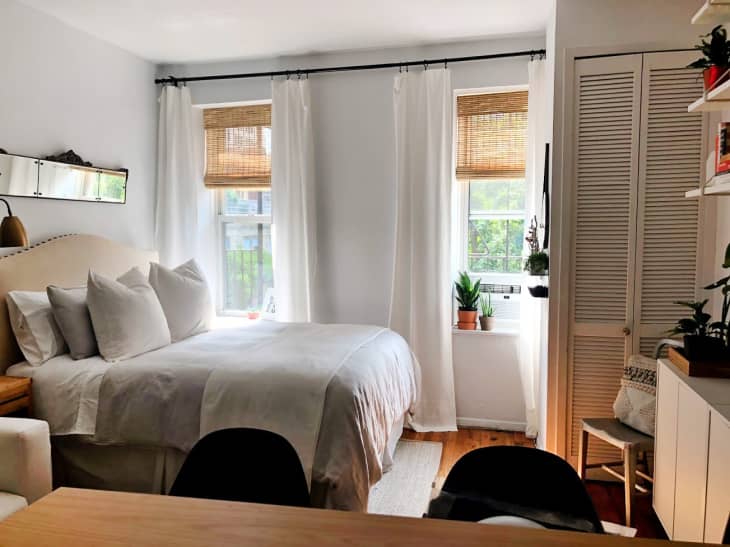This Designer Trick Will Make Your Window Treatments Look Way More Expensive than They Are

We’ve written it before, and we’ll write it again: Window treatments make a room sing. They’re the mascara of a space—that finishing touch, which takes something that’s already pretty good and turns the style dial up a few notches. Of course, aesthetics aside, there are practical pros, too: Privacy, filtering light, and blocking drafts.
If you haven’t gotten on board the drapery train due to having craft beer tastes but a PBR budget (and simply not loving big box options), here’s a designer trick to leveling up basic panels: Pair them with bamboo or other natural fiber shades. The resulting look is layered, warm, and polished. This is something designers do all the time in every room of the house, and the good news is, pricing for these kinds of shades really runs the gamut. Let’s take a look at some examples.
At right around 275 square feet, the above New York studio makes up in elegance what it’s lacking in floor space. The bamboo Roman shades paired with quiet white panels lets plenty of much needed light stream into the small home while adding texture to the neutral palette.
This charming Charlotte, North Carolina, dining room has a similar casual vibe. The white IKEA panels continue the lightness of the space’s wood paneling, and the natural, extra-wide shade picks up on warm rattan, seagrass, and wood tones happening in the other decor. When combined with house plants and other natural textures, these kinds of shades almost give off a tropical vibe.
We love what the bamboo Roman shade does to this sweet nursery. Most of the colors happening here are on the cooler side—mint green, taupey gray, dusty blue. With a white panel alone, the space might have lacked the coziness factor it has, which feels so inviting.
For anyone who’s started to think the bamboo shade and drapery panel equation works only with neutral palettes, this Asheville, North Carolina, living room will shatter those assumptions. Homeowner Melanie paired rosy velvet curtains from West Elm with darker brown bamboo shades, achieving a toned down, glam vibe. We’re into it.
Elsewhere in that same house, a fun pom pom trim livens up these earthy shades. This room is also an example that you don’t have to do the layered thing on every window in the same space. Feel free to mix it up where you want a little more drama, and then hold back where you visually have enough going on. Here, the pillows and bedding below the drape-less window balance out that part of the room.
Same idea, different home. Katie opted for a bamboo shade on the sliding window in her Sunland-Tujunga, California, bedroom. Because its placement is higher up, she likely didn’t need the privacy that traditional blinds would bring but still needed to filter light. She also raised her curtain rod to the roofline, making the ceilings appear loftier in the process. This is another great trick to make your window treatments work harder for you.
This bedroom is in the home of a wallpaper designer, and all the special pops of print throughout are definitely worth a gander. But right now, we’re here for the windows. While this sweet spot certainly has enough texture happening via the rug, linen bedding, and botanical-covered bed wall, the addition of sheer, flax-hued draperies adds a softness that’s so nice to have in your sleeping quarters. Plus, they’re an another slight light blocker if you’re someone who doesn’t need pitch darkness to snooze.
And finally, this Scandi-meets-boho Dallas remodel really hits this idea out of the park. Striking a balance between what feels like two opposing styles isn’t easy, but the layered window covering trick is actually a great segue between different aesthetics. You get all the traditional vibes of drapery panels, plus that little bit of a relaxed, boho feeling from the natural fiber shades.
Now for a little shopping. Remember, bamboo shades are available at a variety of price points, and you’ll typically find them in two styles—Roman and roller—and in a decently wide spectrum of natural tones.
Aymeric Tuscan SemiSheer Brown Roman Shade
This natural fiber Roman shade is cordless, so it’s a great option for households with kids and pets. Most common window sizes are in stock, so you shouldn’t have to get these kinds of shades made to order.
Buy: Aymeric Tuscan SemiSheer Brown Roman Shade, Starting at $42.99 $39.99 from AllModern
Bali Cordless Custom Natural Shade
This Bali style stocked at Pottery Barn has an extra finished look, thanks to the decorative cornice at its top. For the perfect amount of privacy and light filtering, you can’t go wrong with a natural fiber shade like this.
Buy: Bali Cordless Custom Natural Shade, Starting at $160 $128 from Pottery Barn
Bamboo Roman Window Shade
For custom shades on a budget, look no further than Amazon. This vendor will cut bamboo shades to the 1/16th of an inch, and they also offer a wide variety of finishes, including this pretty white-washed look.
Buy: Bamboo Roman Window Shade , $46.99 from Amazon
Ridge Cordless Roller Wicker Shade
This cordless style is actually crafted out of paper by artisans committed to fair trade practices. Paper is a little more tightly woven than bamboo, so these shades would be great in a bedroom where blocking light is more important. Mount them on the inside our outside of your window.
Buy: Ridge Cordless Roller Wicker Shade, Starting at $74 from Pine Cone Hill
Grasscloth Roller Shade
If you’re looking to go super custom, The Shade Store is your best friend. They make a grasscloth version of this natural fiber trend, and it can be cut to fit any window—but that level of personalization comes at a steeper price.
Buy: Grasscloth Roller Shade, Starting at $330 $297 from The Shade Store